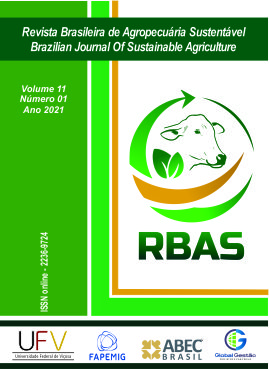Zootechnical performance of Nile tilapia with diets based on cassava residues
DOI:
https://doi.org/10.21206/rbas.v11i1.11287Palabras clave:
family farming, cassava peel, Oreochromis niloticus, sweep of tapiocaResumen
This research aimed to evaluate the use of residues from the processing of cassava, available in the North and Northwest Fluminense regions, replacing some traditional ingredients in the Nile tilapia diet. The experiment lasted 112 days. 840 tilapia fry were used, distributed in 12 hapas and divided into three treatments composed of different isoproteic and isocaloric diets, one control diet without inclusion of residue and two experimental diets, one with the inclusion of cassava peel flour and the other with inclusion of tapioca sweeping flour. The diet with the inclusion of cassava peel showed a zootechnical result similar to the control diet, and the inclusion of agro-industrial residue from tapioca dusting flour has been shown to provide this performance significantly superior. The evaluations carried out in this study indicate that the residues from the cassava processing are foods with potential for use in feed for Nile tilapia in partial replacement to energetic ingredients such as corn and wheat, without compromising the productive performance and reducing the cost of food, taking into account the use of agro-industrial waste present in the region.
Descargas
Descargas
Publicado
Cómo citar
Número
Sección
Licencia
Derechos de autor 2021 Brazilian Journal of Sustainable Agriculture

Esta obra está bajo una licencia internacional Creative Commons Atribución-NoComercial-SinDerivadas 4.0.
1. Proposta de Política para Periódicos de Acesso Livre
Autores que publicam nesta revista concordam com os seguintes termos:
Autores mantém os direitos autorais e concedem à revista o direito de primeira publicação, com o trabalho simultaneamente licenciado sob a Licença Creative Commons Attribution que permite o compartilhamento do trabalho com reconhecimento da autoria e publicação inicial nesta revista.












